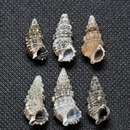Comprehensive Description
provided by Smithsonian Contributions to Zoology
Cerithium dialeucum Philippi, 1849
Cerithium dialeucum Philippi, 1849:2–3 (14–15, pl. 1: fig. 5 [type not found; no locality given; neotypc herein designated: USNM 862619, 34.3 mm × 14.2 mm, S side of Mathuata Id, N coast of Viti Levu, Fiji].—Sowerby, 1855:860. pl. 180: figs. 98, 99; 1865, pl. 3: fig. 18.—Tryon, 1887:130, pl. 23: figs. 87, 88.—Kobelt, 1895:167–168, pl. 31: figs. 8, 9.—Salvat and Rives, 1975:268, fig. 61.—Cernohorsky, 1978:51, pl. 13: fig. 4.
Cerithium suturale Philippi, 1849:2, (14), pl. 1: fig. 4 [type not found, no locality given; not Cerithium suturale Risso, 1826, nor Buvignier, 1843].—Sowerby, 1855:860, pl. 178: figs. 52, 53; 1865: pl. 8: fig. 54.—Tryon, 1887:123, pl. 20: fig. 24.—Kobelt, 1895:166–167, pl. 31: figs. 6, 7.
Cerithium striatum Hombron and Jacquinot, 1852, Atlas; pl. 23: figs. 16, 17 [holotype: MNHNP, no number, 23.3 mm × 18.1 mm; type locality: New Zealand (in error, herein corrected and restricted to Viti Levu, Fiji); not Cerithium striatum Deshayes, 1833, nor Lea, 1833, nor Giebel, 1848]; 1854:100.—Tryon, 1887:130.
Cerithium bicolor Hombron and Jacquinot, 1852, Atlas: pl. 23: figs. 14, 15 [holotype: MNHNP, no number, 24 mm × 10.5 mm; type locality: New Zealand, in error, herein corrected and restricted to Viti Levu, Fiji; not Cerithium bicolor C.B. Adams, 1845].
Cerithium kobelti Dunker, 1877:67; 1882:106, pl. 4: figs. 8, 9.—Kira, 1962:26, pl. 13: fig. 16.—Kuroda and Habe. 1971:113, pl. 16: figs. 7–9.—Shirai, 1980:276.
Cerithium (Proclava) kobelti Dunker.—MacNeil, 1960:41–42, pl. 11: fig. 21 [not Cerithium kobelti Dunker, 1877; is Cerithium tenellum Sowerby, 1855].
Cerithium ravidum Philippi.—Cernohorsky, 1972:64, pl. 14: fig. 2 [not Cerithium ravidum Philippi; is Cerithium dialeucum Philippi, 1849].
Cerithium (Cerithium) tenellum Sowerby.—Springsteen and Leobrera, 1986:63, pl. 14: fig. 10 [not Cerithium tenellum Sowerby, 1855; is Cerithium dialeucum Philippi, 1849].
DESCRIPTION.—Shell (Figures 45–47): Shell light, turreted, highly sculptured, comprising 13 or 14 inflated, angulate whorls reaching 34.8 mm length and 15.9 mm width. Protoconch unknown. Early teleoconch whorls (Figure 45D) with broad, sloping, subsutural ramp and sculptured with 2 spiral threads on third whorl, 3 on fourth whorl, and 4 on fifth whorl. Adult teleoconch sculptured with 4, sometimes 3 main, nodose spiral cords with single smaller spiral cord in each interspace, and many fine spiral striae, crossed over by strong axial ribs. Smaller, frequently beaded, spiral cords and crossover points strongly nodose or spinose, with dominant, most nodose cord on whorl periphery. Subsutural cincture or band produced by 2 or 3 small, beaded spiral threads. Penultimate whorl with 8–19 axial ribs. Thick, angulate varices randomly distributed over shell whorls. Suture impressed, distinct and wavy. Body whorl wide, with moderately excavated base and large, prominent varix opposite outer lip of aperture. Body whorl sculptured with broad subsutural cincture, 5 or 6 main, nodulose spiral cords, and numerous smaller, beaded spiral cords of varying strength. Aperture ovate, wide, about one-third the shell length. Columella concave with thick callus and well-defined lip. Anterior siphonal canal elongate, tubular, strongly constricted, reflected dorsally and to left of shell axis. Anal canal well defined, deep, bordered with strong, parietal, columellar tooth. Outer lip of aperture thick at edge, strongly crenulate, spirally toothed and grooved within. Shell color highly variable, but usually with white or tan background overlain by darkly pigmented brown, tan, purple-black stripes or bands. Dark spiral band frequently on subsutural cincture. Japanese specimens (kobelti morphs) usually with yellow beads or all yellow-tan. Protoconch dark purple. Aperture white; inside of outer lip of aperture with brown stripes. Measurements (Table 18). Periostracum tan, thin.
Radula (Figure 48): Type-1 radular ribbon (Figure 3A) short, a little less than one-ninth the shell length. Rachidian tooth (Figure 48B,C) triangular with long median posterior projection and pair of basal ridges on basal plate. Anterior front of rachidian tooth concave; cutting edge with spade-shaped main cusp flanked on each side by two small, blunt denticles. Lateral tooth (Figure 48B,C) with strong, posteriorly projecting, buttress-bearing, small pustule, and long narrow, lateral, posterior projection. Marginal teeth (Figure 48B–D) with curved, serrated tips and spatulate bases. Inner marginal tooth with long, spoon-shaped main cusp, 3 inner flanking denticles, and 2 outer flanking denticles. Outer marginal tooth same, but lacking outer flanking denticles.
Anatomy (Figure 49): Head-foot pinkish with small white, orange, and brown flecks and larger blackish blotches. Deep ciliated groove on right side of female foot terminating in small, bulbous ovipositor. Snout thick, broad, bilobed. Cephalic tentacles broad at peduncular bases and relatively short. Eyes orange. Mantle edge fringed with elongate, tapering, pale yellow papillae. Inhalant siphon large, muscular, bright orange interiorly, and fringed with yellow papillae. Dorsal surface of mantle with long, narrow, orange stripes.
Osphradium tall, green, extending length of ctenidium. Ctenidium tan, narrow, comprised of long, tapering filaments. Hypobranchial gland brown, thick, glandular.
Buccal mass of moderate size with short radula and pair of semilunar jaws having scale-like surface. Salivary glands a pair of thin, uncoiled tubes running through nerve ring. Esophageal gland wide, well developed.
Type-B palliai oviduct (Figure 4B) with short, wide, anterior sperm gutter (Figure 49, sg). Sperm gutter with two openings (Figure 49, osb, oasr); one to large spermatophore bursa (Figure 49, sb), extending length of medial lamina; the other opening (Figure 49, oasr) adjacent to first, becoming narrow, thin-walled tube in outer edge of medial lamina and leading into small posterior seminal receptacle (Figure 49, psr) at posterior edge of medial lamina. Free edge of medial lamina concave, especially in middle of lamina, and highly ciliated, forming broad sperm gutter (Figure 49, sg). Anterior edge of thin-walled lateral lamina with long ciliated tube probably functioning as anterior seminal receptacle (Figure 49, asr). Outside of tube highly ciliated and fitting into concave edge of medial lamina.
SYNONYMIC
- bibliographic citation
- Houbrick, Richard S. 1992. "Monograph of the genus Cerithium Bruguiere in the Indo-Pacific (Cerithiidae: Prosobranchia)." Smithsonian Contributions to Zoology. 1-211. https://doi.org/10.5479/si.00810282.510

